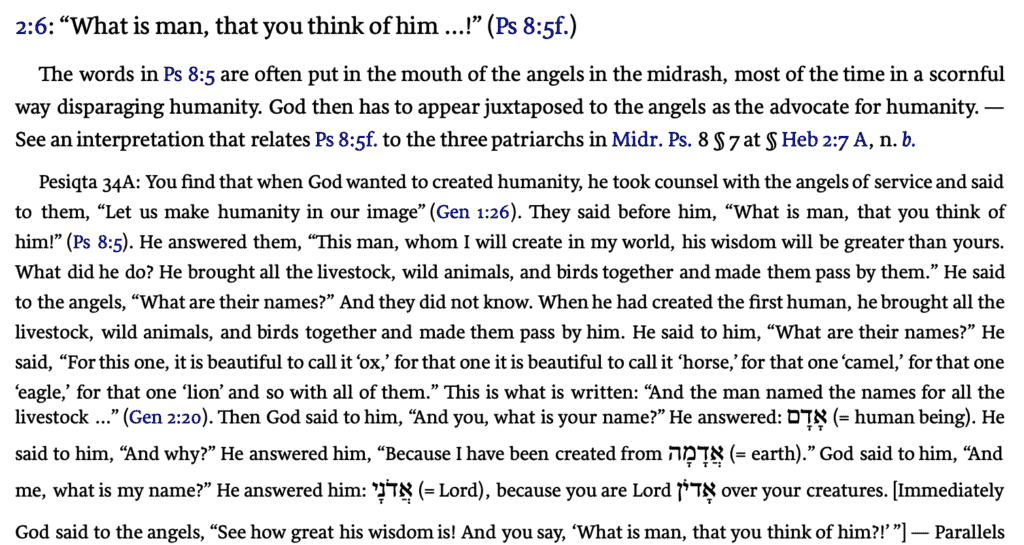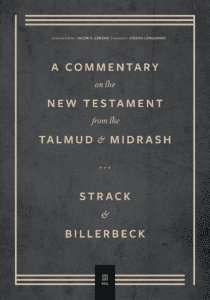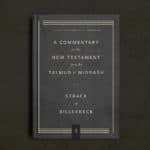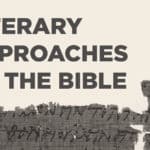
Hermann Strack and Paul Billerbeck’s Commentary on the New Testament from the Talmud and Midrash (often abbreviated as “Strack-Billerbeck”) is a reference work for illustrating the concepts, theological background, and cultural assumptions of the New Testament. According to G.K. Beale, the resource is also especially helpful in studying the New Testament’s use of the Old. As Beale says, “sometimes looking at a NT employment of the OT through the lens of a non–Christian Jewish use brings new vistas of perspective.”
Beale explains how one can use Strack-Billerbeck for study of the NT’s use of OT:
- The researcher is able to collect citations and discussions in Judaism of many of the specific OT texts under focus in the NT.
- One can summarize any patterns, trends, or similar uses or similar ideas observable in these Jewish uses of the OT text.
- One can compare these Jewish uses in their own Jewish contexts to the way the OT text is used in the NT and its context. Here it is important to evaluate whether the non–Christian Jewish uses are similar to the NT use. If so, does the Jewish use give a better understanding of the NT use?
Inspired by Beale’s recommendation, this blog post will illustrate Strack-Billerbeck’s usefulness for studying the NT use of the OT by examining some comments on Psalm 8 in Hebrews 2:5–9.
Psalm 8 in Hebrews 2:5–9
Hebrews 2:5–9 reads as follows:
For it was not to angels that God subjected the world to come, of which we are speaking. It has been testified somewhere,
“What is man, that you are mindful of him,
or the son of man, that you care for him?
You made him for a little while lower than the angels;
you have crowned him with glory and honor,
putting everything in subjection under his feet.”Now in putting everything in subjection to him, he left nothing outside his control. At present, we do not yet see everything in subjection to him. But we see him who for a little while was made lower than the angels, namely Jesus, crowned with glory and honor because of the suffering of death, so that by the grace of God he might taste death for everyone.
At the outset it can be noted that Hebrews 2:5–9 reads Psalm 8 in at least two surprising ways:
- While Psalm 8 seems to see mankind as subjected to the angels, Hebrews interprets its words to indicate that this is temporary.
- While Psalm 8 seems to be concerned with humanity generally, Hebrews applies it to Christ specifically.
Psalm 8 in Strack-Billerbeck
While neither of the above points seem self-evident in Psalm 8, Strack-Billerbeck reveals that Jewish interpreters saw similar strands of thought in the psalm.
For example, the commentary on Heb 2:6 notes that Ps 8:5 was often read as the words of the angels, questioning God’s high regard for man by creating him in his image. God responds to these angels that “his wisdom will be greater than yours.” This hints that Jewish interpreters saw God’s creation of humanity in his image as containing a latent superiority to the angels.

Additionally, Strack-Billerbeck’s commentary on Heb 2:7 suggests that the Midrash on Psalm 104 might be relevant here. It sees God’s majesty and glory as being bestowed in the Messiah in the future, and quotes Ps 104:1 and Ps 21:4, 6. The similarity of language between Psalm 8 and Psalm 21 might be illuminating for how Hebrews interprets Psalm 8 individually for Jesus.

The great value of Strack-Billerbeck
While Strack-Billerbeck was originally published between 1922 and 1928, it remains unparalleled today. Written in German, Lexham Press’ English translation brings this resource into the hands of a new audience.
Beale says that “scholars, pastors, and serious readers of the New Testament whose German is rusty or non-existent now will be able to use this English translation of Strack-Billerbeck with great value, especially in studying the New Testament’s use of the Old.”
Beale cautions that “of course, Strack-Billerbeck must be used together with other Jewish sources (e.g., like Qumran, early Jewish Apocalyptic and pseudonymous literature, Philo, and Josephus).” Readers should also “pay attention to Instone Brewer’s introduction,” which explains how to best use the commentary.
Strack and Billerbeck’s Commentary on the New Testament from the Talmud and Midrash can play a unique and irreplaceable role in one’s study of the NT use of the OT.
Many thanks to G.K. Beale for his personal correspondence on Strack-Billerbeck that inspired this blog post. The images are screenshots from Hermann Strack and Paul Billerbeck’s Commentary on the New Testament from the Talmud and Midrash: Volume 3, Romans through Revelation in Logos Bible Software.







